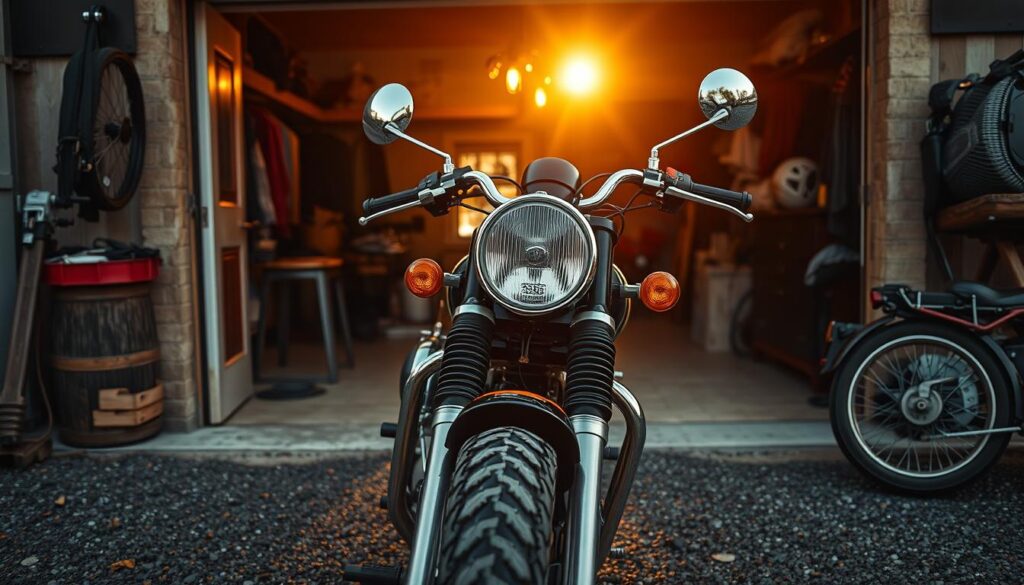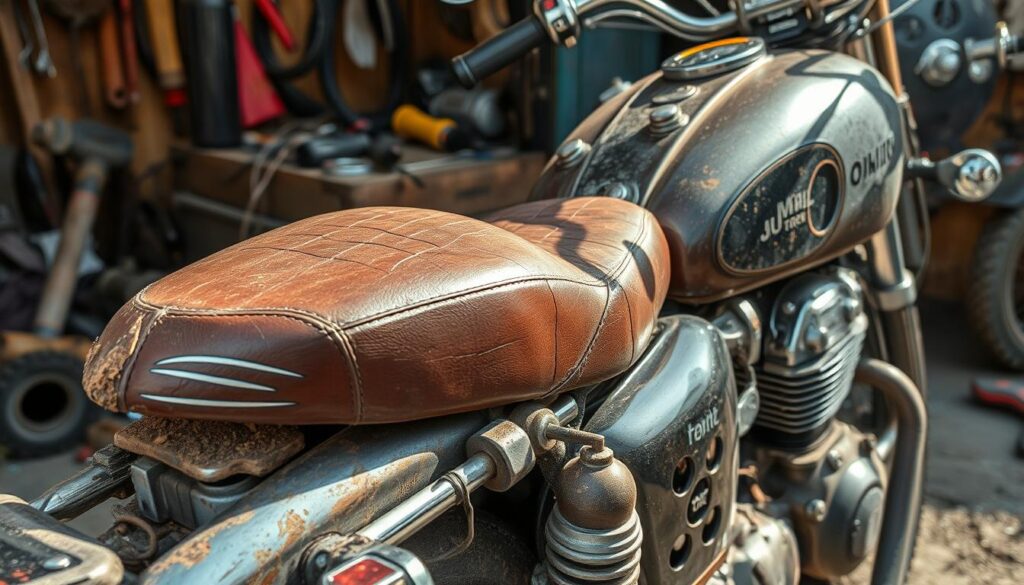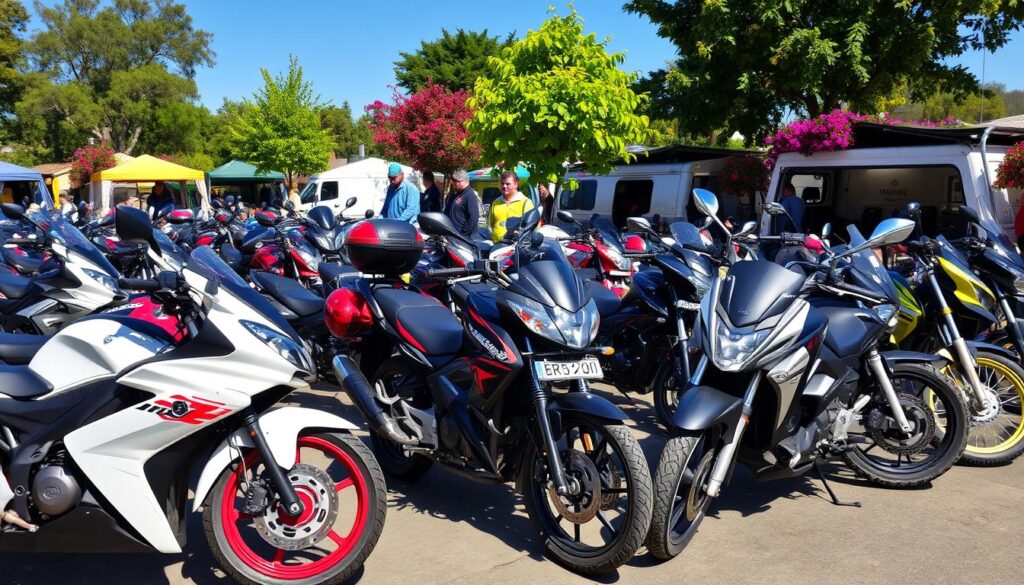I still remember the excitement of buying my first used bike. It was more than just a ride; it was freedom and adventure. If you’re thinking about getting a used motorcycle, this guide will help you.
In This Guide
Why Buying Used Motorcycle Makes Financial Sense
Choosing between a new or used motorcycle affects your budget. Looking into the pre-owned motorcycle purchase can save you money. It’s a smart way to spend less over time.
Depreciation Benefits Explained
Buying a used motorcycle helps avoid big depreciation losses. New bikes often lose 30% of their value in the first year. A used bike avoids this drop, saving you money.
Cost Comparison: New vs Used
Used motorcycles are cheaper than new ones. They can be 40-60% less expensive. This means more money for customizations or other bike-related costs.
Insurance Considerations for Pre-owned Bikes
Insurance for a used motorcycle is often cheaper. Since used bikes are worth less, insurance costs are lower. This makes riding more affordable and worry-free.
“Buying a used motorcycle can be an excellent way to get the most value for your money and enjoy the freedom of the open road without breaking the bank.”
Understanding depreciation, cost savings, and insurance can show the value of a pre-owned motorcycle purchase. It’s a wise financial choice. It helps you find a bike that fits your budget and riding style.
Current Market Trends in Pre-owned Motorcycles
When you’re looking at the secondhand bike buying guide, knowing the current trends is key. The used motorcycle market has changed a lot lately. This is due to what buyers want and how prices change.
Adventure and dual-sport motorcycles are getting more popular. These bikes are great for both city streets and dirt trails. Riders love them for their ability to do it all. Bikes like the BMW GS series, Honda Africa Twin, and Suzuki V-Strom are in high demand.
Classic and retro-style motorcycles are also on the rise. Models from Triumph, Ducati, and Indian are attracting buyers. They want bikes that look old but ride like new. These bikes often sell for more because they’re rare and beautiful.
| Motorcycle Segment | Pricing Trend | Popularity Ranking |
|---|---|---|
| Adventure/Dual-Sport | Moderate to High | 1 |
| Classic/Retro | High | 2 |
| Sport Bikes | Moderate | 3 |
| Cruisers | Low to Moderate | 4 |
When you’re checking out used motorcycles, keep up with these trends. Knowing what’s popular can help you find the perfect bike. It should match your riding style and budget.
Research and Planning Before Your Purchase
Buying a used motorcycle requires careful research and planning. You need to know about popular brands and models. Also, figuring out your budget and financing options is key. This guide will help you make a smart choice.
Popular Motorcycle Brands and Models
Start by learning about top motorcycle brands and models. Knowing this helps you find the right bike for you. Look into brands like Honda, Yamaha, Suzuki, Kawasaki, and Harley-Davidson. They offer a wide range of bikes for different riding styles and budgets.
Determining Your Budget and Financing Options
Setting a budget is crucial when buying a used motorcycle. Think about the cost, insurance, maintenance, and any repairs or upgrades. Look into financing options like personal loans or motorcycle-specific loans. Even consider certified pre-owned motorcycles from dealers for more flexibility and warranty.
Best Seasons for Buying Used Motorcycle
- Spring and Fall are great times to buy a used motorcycle. Demand is lower, and sellers might be more willing to negotiate.
- Winter can also be a good time to find deals. Dealers and private sellers might want to clear out their inventory.
- Always do your research, inspect the bike well, and negotiate the best price. This way, you’ll get a good deal.
By following these steps, you’ll be ready to find the perfect used motorcycle. Remember, good research and planning are essential for a successful purchase.
Essential Documents and Legal Requirements
Buying a used motorcycle from a private seller or a certified pre-owned program has its legal steps. It’s important to know these to make the buying process smooth and legal.
Private Seller Motorcycle Purchase
When buying from a private seller, you need the vehicle’s title. This title should be signed over to you. Make sure the title doesn’t have any liens or debts. You also need to transfer the registration and insurance to your name.
Certified Pre-Owned Motorcycles
Certified pre-owned motorcycles have a simpler process. The dealership will take care of the title and registration paperwork. Still, it’s key to check all the documents and know about the warranty and certification.
Registration and Titling
- Get the vehicle’s title, signed over to you by the seller
- Finish the registration transfer at your local DMV
- Check that the motorcycle’s VIN (Vehicle Identification Number) matches the title
- Get the right license plates and tags for your state
Knowing the legal steps and documents is key. It helps you buy a used motorcycle confidently. This is true whether you’re buying from a private seller or a certified pre-owned program.
Complete Used Motorcycle Inspection Checklist
Before buying a used motorcycle, it’s key to check it well. This helps you know its condition and find any problems. This checklist will help you check the bike and make a smart choice.
Mechanical Components to Examine
- Look for engine leaks, odd noises, or damage.
- Check the brakes for good condition and function.
- Check the suspension for proper working and wear.
- Look at the tires for enough tread, even wear, and correct air.
- Test the electrical system, like lights and battery, to see if they work right.
Test Ride Guidelines
Doing a test ride is key when checking a used motorcycle. Here’s how to do it right:
- Start the bike and warm it up before riding.
- Test how it accelerates, brakes, and handles in a safe area.
- Check if the transmission and clutch work smoothly.
- Make sure the bike goes straight and doesn’t pull to one side.
- See how it performs at different speeds and conditions.
Red Flags to Watch For
Look out for these signs of trouble or past accidents during the check and ride:
- Mismatched or worn-out parts
- Visible repairs or changes
- History or documents that don’t match up
- Odd vibrations, noises, or handling
- Too much wear on the frame, handlebars, or other parts
By using this detailed checklist, you can choose a reliable and safe used bike. A good inspection can prevent expensive and risky problems later.
Negotiating with Private Sellers vs Dealerships
Buying a used motorcycle is exciting, but negotiating is key. Whether you’re looking at a private seller motorcycle purchase or a certified pre-owned motorcycles, knowing how to negotiate is crucial. It helps you get the best deal.
Private sellers are often more flexible and personal. They might be emotionally attached to their bikes. Start by finding the motorcycle’s fair market value. Then, offer a reasonable price based on the bike’s condition and mileage. Be ready to negotiate, but also be respectful.
Dealerships, on the other hand, have a more set pricing and negotiation style. They might not be as emotionally attached, but they’re skilled negotiators. To get a good deal, research the market value and have evidence of similar sales. Don’t be afraid to counter their first offer politely. The goal is to find a deal that works for both sides.
- Understand the fair market value of the motorcycle you’re interested in.
- Prepare a well-researched and reasonable offer, taking into account the bike’s condition and mileage.
- Be willing to negotiate, but remain respectful and professional in your approach.
- Provide evidence of comparable sales to support your negotiation position.
- Be prepared to compromise, but don’t settle for a deal that doesn’t align with your budget or needs.
“Negotiation is not about winning or losing; it’s about finding a mutually beneficial solution.”
Whether you’re talking to a private seller or a dealership, the secret to success is research, confidence, and flexibility. With the right approach, you can get the best deal on your used motorcycle.

Understanding Motorcycle History and Maintenance Records
When you’re looking to buy a used motorcycle, it’s key to check its history and maintenance records. This info gives you a clear picture of the bike’s condition, who owned it, and how well it was cared for. It helps you choose wisely, matching your needs and budget.
Decoding VIN Numbers
The first thing to do is decode the bike’s VIN. This 17-digit code tells you who made the bike, when, and even the details of its production. By looking closely at the VIN, you might find signs of past accidents, repairs, or other issues.
Service Documentation Review
Reviewing the bike’s service records is also important. Look for records of oil changes, tune-ups, and big repairs or replacements. This tells you if the bike was well-maintained by its previous owners.
Previous Owner Background Check
Checking up on the bike’s previous owners can also be enlightening. You might learn about their riding experience, maintenance habits, and any accidents. Knowing about the owner’s history helps you understand the bike’s condition better.
Investigating a used motorcycle’s history and maintenance records carefully can lead to a better purchase. This research can save you time, money, and trouble in the long run.
Common Pitfalls When Buying Used Motorcycle
Buying a used motorcycle can save you money. But, it’s important to watch out for potential problems. Look out for these common issues to make sure you have a smooth transaction.
One big risk is missing hidden damage or mechanical problems. The seller might say the bike is perfect, but you need to check it yourself. A bad bike can cost you a lot of money, making the savings from buying used less.
Don’t ignore the bike’s maintenance history. A bike that’s been well taken care of is a better deal than one that hasn’t. Check the service records to make sure it’s been properly looked after.
- Be careful of deals that seem too good. They might be scams or have hidden problems.
- Don’t skip researching the bike’s market value. This can help you avoid paying too much.
- Make sure you know about legal and registration needs. Ignoring these can cause big problems later.
Knowing these common pitfalls can help you buy a used motorcycle with confidence. You’ll find the right bike for your needs and budget.

| Potential Pitfall | Explanation |
|---|---|
| Hidden Damage or Mechanical Issues | Failing to conduct a thorough inspection and test ride can lead to costly repairs. |
| Ignored Maintenance History | A well-maintained bike with detailed service records is a better investment than one with an unknown history. |
| Unrealistic Deals | Deals that seem too good to be true may be a sign of a scam or a bike with hidden issues. |
| Lack of Market Research | Failing to research the market value can leave you vulnerable to overpaying. |
| Legal and Registration Issues | Overlooking important legal and registration requirements can lead to costly complications. |
Post-Purchase Maintenance and Upgrades
Congratulations on your pre-owned motorcycle purchase! As an experienced rider, you know that owning a used bike needs extra care. Proper maintenance and strategic upgrades will make your financing used motorcycle last for years.
Initial Service Requirements
Before you ride, get a detailed service check from a trusted mechanic. This will spot any urgent issues or repairs needed. Common tasks include:
- Oil and filter change
- Brake system inspection and adjustment
- Tire evaluation and replacement if needed
- Thorough cleaning and lubrication of moving parts
Essential Upgrades to Consider
Even if your used motorcycle is in good shape, think about a few key upgrades. These can improve performance, comfort, and safety. Popular upgrades include:
- High-quality tires for better traction and handling
- Upgraded braking components for stronger, more reliable stops
- Comfortable seating and grips for long-distance riding
- Auxiliary lighting to increase visibility on the road
Building a Maintenance Schedule
Creating a regular maintenance routine is key for your motorcycle’s long life. Work with your mechanic to set up a schedule. This should include:
| Maintenance Task | Frequency |
|---|---|
| Oil and filter change | Every 3,000 miles |
| Tire rotation and balance | Every 5,000 miles |
| Brake system inspection | Every 6 months |
| Suspension and steering check | Annually |
Following this schedule will keep your pre-owned motorcycle in top shape. This ensures a safe and reliable ride for years.
Conclusion
Buying a used motorcycle can be a smart choice. You’ve learned about depreciation, cost comparisons, and insurance. This knowledge helps you find a bike that fits your budget and needs.
The market has many pre-owned motorcycles to choose from. You can find the perfect bike for your style and preferences. With careful research and a detailed inspection, you can find a reliable and well-kept motorcycle.
Whether you buy from a private seller or a dealership, this guide helps you. You’ll know how to negotiate and make a smooth purchase. Understanding the bike’s history, maintenance records, and potential issues helps you avoid risks and enjoy your new ride.

